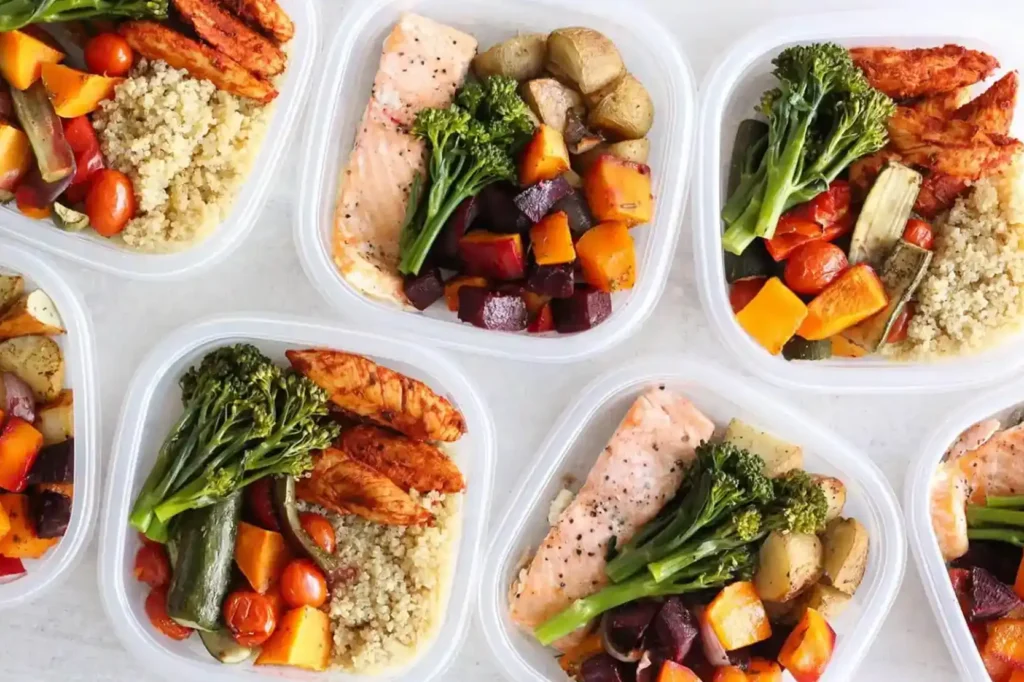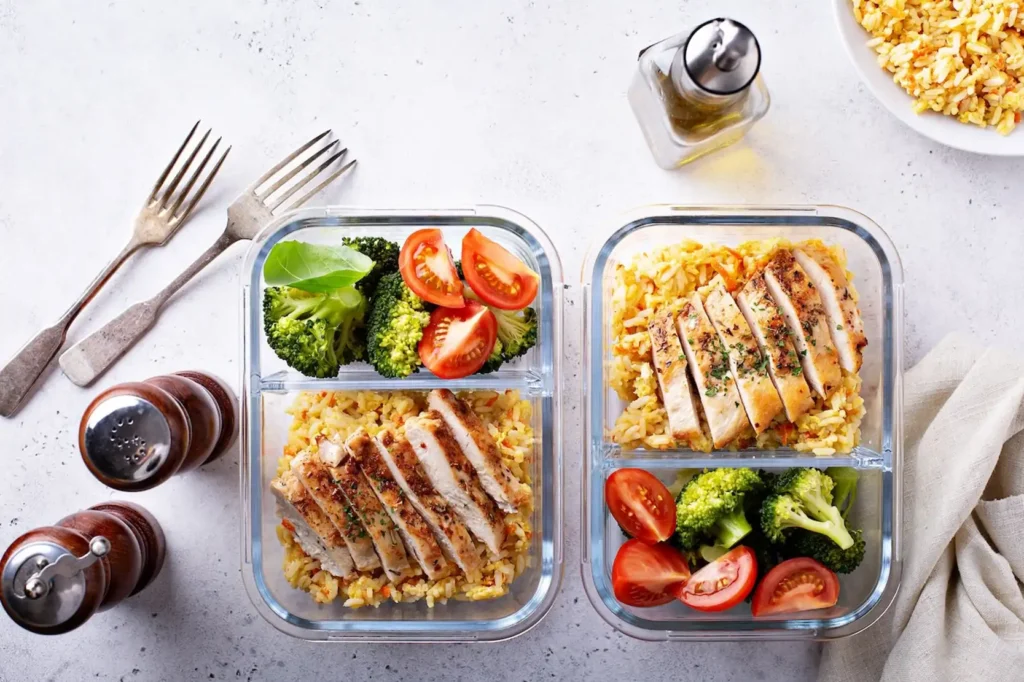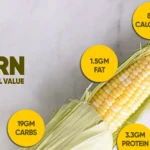Discover healthy meal prep ideas for weight loss that are practical, delicious, and effective. This guide provides actionable tips for planning, portioning, and preparing balanced meals to help you achieve your weight loss goals.
Introduction to Healthy Meal Prep Ideas for Weight Loss:
When it comes to weight loss, consistency is key, and meal prepping is one of the most effective ways to stay on track. By planning and preparing your meals in advance, you can avoid unhealthy food choices, control portion sizes, and ensure you’re fueling your body with nutrient-dense foods. Whether you’re a busy professional, a parent juggling multiple responsibilities, or someone simply looking to simplify their eating habits, healthy meal prep ideas for weight loss can be a game-changer. This guide will walk you through practical, delicious, and sustainable meal prep strategies to help you achieve your weight loss goals without feeling deprived.
Meal prepping doesn’t have to be complicated or time-consuming. With a little planning and the right recipes, you can create meals that are not only healthy but also satisfying and flavorful. The key is to focus on whole, unprocessed foods like lean proteins, whole grains, fresh vegetables, and healthy fats. By incorporating these elements into your meal prep routine, you’ll be able to maintain a calorie deficit while still enjoying your food. Let’s dive into some actionable tips and ideas to make your meal prep journey a success.
Absolutely! Focus on plant-based proteins like beans, lentils, tofu, and tempeh, and pair them with plenty of vegetables and whole grains.
1. Start with a Plan: The Foundation of Successful Meal Prep:
Before you even step into the kitchen, take some time to plan your meals for the week. This step is crucial because it helps you stay organized and ensures you have all the ingredients you need. Start by deciding how many meals you want to prep breakfast, lunch, dinner, and snacks. Then, choose recipes that align with your weight loss goals and dietary preferences.
When planning, consider your schedule. If you know you’ll have a busy week, opt for simple recipes that require minimal cooking time. Use a mix of fresh and frozen ingredients to save time and reduce food waste. For example, frozen vegetables are just as nutritious as fresh ones and can be a lifesaver when you’re short on time. By having a clear plan, you’ll be less likely to reach for unhealthy options when hunger strikes.

2. Focus on Balanced Meals: Protein, Carbs, and Healthy Fats:
A balanced meal is essential for weight loss because it keeps you full and satisfied while providing the nutrients your body needs. Aim to include a source of lean protein, complex carbohydrates, and healthy fats in every meal. For example, grilled chicken breast (protein), quinoa (carbs), and avocado (healthy fats) make a delicious and balanced combination.
Protein is particularly important for weight loss because it helps preserve muscle mass and keeps you feeling full longer. Good sources include chicken, turkey, fish, tofu, beans, and Greek yogurt. Pair your protein with fiber-rich carbs like brown rice, sweet potatoes, or whole-grain pasta to keep your energy levels stable. Don’t forget to add healthy fats like olive oil, nuts, or seeds to support overall health and satiety.
3. Portion Control: The Secret to Staying Within Your Calorie Goals:
Even healthy foods can contribute to weight gain if you eat too much of them. That’s why portion control is a critical aspect of meal prepping for weight loss. Use measuring cups, a food scale, or portioned containers to ensure you’re eating the right amount of each food group.
A simple way to portion your meals is to follow the “plate method.” Fill half your plate with non-starchy vegetables like broccoli, spinach, or bell peppers. Reserve a quarter of your plate for lean protein and the remaining quarter for complex carbs. This method ensures you’re getting a variety of nutrients without overeating. Pre-portioning your meals into containers also makes it easy to grab and go, reducing the temptation to overindulge.
4. Keep It Interesting: Variety Is the Spice of Life:
One of the biggest challenges of meal prepping is avoiding boredom. Eating the same meals day after day can make it harder to stick to your weight loss plan. To keep things exciting, rotate your recipes and experiment with different flavors and cuisines. For example, try a Mexican-inspired bowl with grilled chicken, black beans, and salsa one week, and switch to an Asian-inspired stir-fry with tofu and vegetables the next.
Don’t be afraid to get creative with your seasonings and sauces. Herbs, spices, and low-calorie condiments like mustard, hot sauce, or balsamic vinegar can add a lot of flavor without adding extra calories. By keeping your meals varied and flavorful, you’ll be more likely to stick to your plan and enjoy the process.
5. Prep in Batches: Save Time and Effort:
Batch cooking is a meal prepper’s best friend. Instead of cooking individual meals, prepare large quantities of staple ingredients that can be mixed and matched throughout the week. For example, cook a big batch of roasted vegetables, grilled chicken, and quinoa on Sunday. Then, use these ingredients to create different meals like salads, wraps, or grain bowls.
Batch cooking not only saves time but also reduces the stress of figuring out what to eat each day. Store your prepped ingredients in airtight containers in the fridge or freezer, and assemble your meals as needed. This approach is especially helpful for busy individuals who don’t have time to cook every day.
FAQ
Most frequent questions and answers
Most prepped meals stay fresh for 3-4 days in the fridge. For longer storage, consider freezing them and reheating as needed.
Absolutely! Focus on plant-based proteins like beans, lentils, tofu, and tempeh, and pair them with plenty of vegetables and whole grains.
While not necessary, investing in good-quality, portioned containers can make meal prepping easier and more organized.
Conclusion:
Meal prepping is a powerful tool for weight loss, helping you stay consistent and make healthier choices. By planning balanced meals, controlling portions, and keeping things interesting, you can create a sustainable routine that supports your goals. Start with these healthy meal prep ideas for weight loss and take the first step toward a healthier, happier you.








